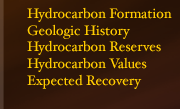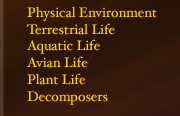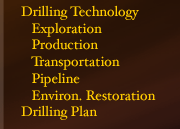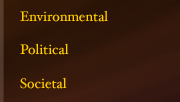
Environmental Implications - Surface Operations
Impact Report: Surface Operations
Of all the aspects of surface operations (pad construction, camp construction, personnel, dining, lodging, maintenance shops, water plants, waste water plants) the largest impact will be caused by the physical existence of the drilling pad. However, all activity has impact, just varying in terms of duration and geographic scope. The impacts of this are listed below, along with a rating of significance. The rating of significance is based on the intensity (magnitude, geographic scope, and frequency/duration) and the probability of occurrence, with the scale being high, moderate, or low. Probability of biological impacts is extremely difficult to predict. Thus, the probability should be evaluated in the context of professional judgment and past occurrences of impacts. In ANWR this is complicated because there has been no prior development to reference to.
ELEVATED PLATFORM
- Support: Steel poles
o Direct impact on permafrost.
Depending on metal used and extent of insulation from high temperature drilling equipment, thawing may occur.
o Attraction for curious, nesting, or hiding animals.
:: Significance:
o Intensity
Magnitude: (LOW) Animals might be scared away from the poles, but since the poles would not block migration, feeding or breeding it is unlikely that it would directly change the size or geographic range of an animal or plant population. The permafrost melting could be minimized with the correct insulation and/or materials.
Geographic Scope: (LOW) The effect would be site specific at a few locations.
Frequency: (HIGH) The poles would be permanently in place
Duration: (LOW) The poles will be removed after the extraction of oil is complete, and therefore will have a finite life of impact
- Operating Surface: Aluminum sheets
o Damage to tundra vegetation by oil leaks
o Damage to tundra vegetation by shading
Could be reduced by having slots or small holes in the pad, allowing some light to get through
:: Significance:
o Intensity
Magnitude: (LOW) This depends on the amount of oil leaked. But since the tundra beneath the platform is already (at least nearly) dead it seems that the effects from oil spills would be a minimal addition to any unavoidable vegetation damage. Animals might come in contact with some leaking oil, but very minimal amounts, and not likely enough to alter an entire population.
Geographic Scope: (LOW) The effect would be site specific at a few locations.
Frequency: (HIGH) The platform would be permanently in place
Duration: (LOW) The pad will be removed after the extraction of oil is complete, and therefore will have a finite life of impact
CONSTRUCTION
- Transportation of the pieces: Helicopter
o Flight will create noise that may be detectable to animals on the ground surface, and occasionally wintering birds
Increased flight elevation will significantly diminish the severity
o No landing pad will be needed as the pieces are to be lowered into place.
Will be increased by holes in pad
:: Significance:
o Intensity
Magnitude: (MODERATE) The impact from the period of construction and removal is understood to be very harsh on both tundra and animals. However, it would not be enough to directly change the size or geographic range of an animal or plant population.
Geographic Scope: (LOW) If the parts are flown in by helicopter, the impact will be site specific at a few locations. If land transport is used then a larger impact might occur.
Frequency: (HIGH) Personnel or equipment would most likely be at the site throughout the construction period
Duration: (LOW) Construction will be very small in terms of the life of the pad, and therefore will have a finite time of impact. The use of the aluminum platform allows for an even smaller construction period, than gravel pads, because gravel pads must wait for the completion of ice roads.
REQUIREMENTS OF PERSONNEL
- Sewage Disposal
o Transport of solids will have noise effects and need for further development of helicopter/plane landing and pumping facilities
This will also be a constant need for gasoline (defeating the purpose of drilling)
o Disposal in or on the tundra will impact the chemical composition of the tundra, and could be especially harmful if water sources are affected.
Possibilities for reuse/recycling should be considered
- Fresh Water
o Fresh water for human use is scarce on the North Slope. Any large needs would deplete fresh water sources for animals, thus possibly beginning a chain of impact through the ecosystem
o Wetland ecosystems would be disturbed by the collection or piping of water from them
Possibilities for desalinization should be considered
- Food
o Transportation of food would cause impacts. See below.
o Storage of food might attract animals.
o Disposal of trash. Might attract animals. Must be flown out eventually (See below).
Note: Possibility in all this for introduction of an invasive species of plant or animal.
- Transportation: People and supplies
o Noise effects from air travel
o Tundra and animals impacted from landing pad/equipment
Ideally a helicopter landing-pad would be on the housing platform adjacent to the drilling platform, to minimize direct tundra impact.
1. Non-seismic exploration
Due to the fact that magnetic and gravitation exploration do not give off magnetic waves, the only effects produced by this method are caused by the service operations associated with the method.
The effects are:
Due to the airplanes used, there will be noise pollution. In addition to that, the nitrous oxides and carbon monoxide produced will reduce the air quality. Mild, wide-spread, short-term.
Any surface operations necessary will be conducted by attaching the magnetic exploration equipment to seismic exploration trucks thus requiring no extra vehicles of transport.
2. Seismic Exploration
A very useful tool that we relied on when conducting our evaluation is the Seismic exploration that was conducted along the coastal plain of the Arctic Refuge during the winters of 1984 and 1985.
Also note that 3-Dimensional subsurface image creation requires a much denser grid than that required for 2-D. The 1984-85 trails were usually four miles apart, whereas the 3-D seismic trails that are currently impacting areas where they are in use are about half a mile (or less) apart. This means that the tracked vehicles will basically blanket the area. 3-D crews are twice the size of 2-D crews, so more than twice the tracked vehicles are out on the tundra (more equipment and more bulldozers to transport the camps). Furthermore, the turns that the heavy equipment need to make are much tighter in 3-D seismic than they are in 2-D seismic, so the damage made to vegetation and the tundra in general is greater.
Strong winds usually blow the snow into depressions, leaving the higher areas with thinner snow cover and making them much more susceptible to impacts from vehicle tracks. After the 1984-85 seismic exploration 1400 miles of trails that have been made by drill, vibrator and recording vehicles impacted the tundra. In addition to the trails left by the exploration equipment, trails were also created by D-7 Caterpillar tractors that pulled ski-mounted trailer-trains between work camps. In 1999, 15 years after the exploration conducted a significant amount of the trails persisted. Some of them became troughs that are visible from the air (all vegetation removed). In other trails, the amount and type of vegetation present changed. This implies that the entire food-web dependant on this vegetation is affected and altered. Animals can be displaced out of their original habitats if their source of food is no longer available. In other areas, permafrost melted and the trails remained wetter than they previously were. Severe, localized, long-term.
Even though the caribou and birds are usually absent from the 1002 Area during the winter months, there are several species that are adapted to the harsh conditions and that remain in the area during the winter. These species are likely to be affected by the seismic exploration activities. They include primarily muskoxen and polar bears, but there are also other species including wolverine, arctic fox and arctic grayling. In addition, the sensitive arctic tundra vegetation is affected. Moderate, localized, short-term.
3. Transportation:
a. Rolligons:
Exerts pressure of about 3psi that is relatively less than an ordinary vehicle.
They would, however, still leave a small footprint on the ground. Mild,
localized, short term.
Atmospheric pollution caused by the use of diesel fuel (see airplanes).
b. Helicopter:
Noise pollution caused by the propellers of the helicopter will affect bird
migration, polar bears, and other animals. Mild, localized, short-term.
Hazard of encountering birds in the air which would increase bird mortality
and decrease the efficiency of the helicopter. Mild, localized, short-term.
At times air travel will not be possible due to extreme weather conditions
which can persist for days. As a result, local storage needs would increase
and more pad area would be required. (see environmental impact of surface
operations). Mild, localized, short-term.
Degradation of air quality: see airplanes.
c. C-130 Hercules
Landing on snow cover may put pressure on the surface. Moderate, localized,
short-term.
May affect air quality. Moderate, wide-spread, short-term.
If an ice strip was used, this would put a strain on water resources since
one million liters are required per air strip. Severe, localized, long-term.
The option of using synthetic materials could be a problem if they are not
biodegradable or if they are toxic. Severe, localized, long-term.
4. Drilling
Permafrost destroyed when drill bits driven into the ground. The area around the drill hole thaws. Severe, localized, long-term.
The flooding technique of recovering oil from the wells will have two
effects:
- It will use up excess H20 Mild, localized, short-term.
- Chemicals will circulate into the ground material. Moderate, localized,
long-term.
Benefits of drilling plan:
- Directional drilling and coiled tubing are the best choice: they will
provide a minimal impact on the environment. Directional drilling allows
for the installation of infrastructure beneath these areas without affecting
the delicate ecosystem; animal habitats and sensitive areas can be avoided
as a result.
- Coiled tubing reduced the amount of waste produced and results in a smaller
footprint. Because the joint connection operations of a convenient drill
string are not required, noise levels are reduced as well.
5. Pipeline
Permafrost thaws around pole-support structure. Mild, localized, short-term.
Vegetation does not grow underneath sunlight due to lack of sunlight. Mild,
localized, long-term.
Potential fragmentation of habitats. Ex. Caribou might not want to cross
underneath pipeline, and although they are not highly active around this
area, their migratory route still runs through there. Moderate, wide-spread,
long-term.�





